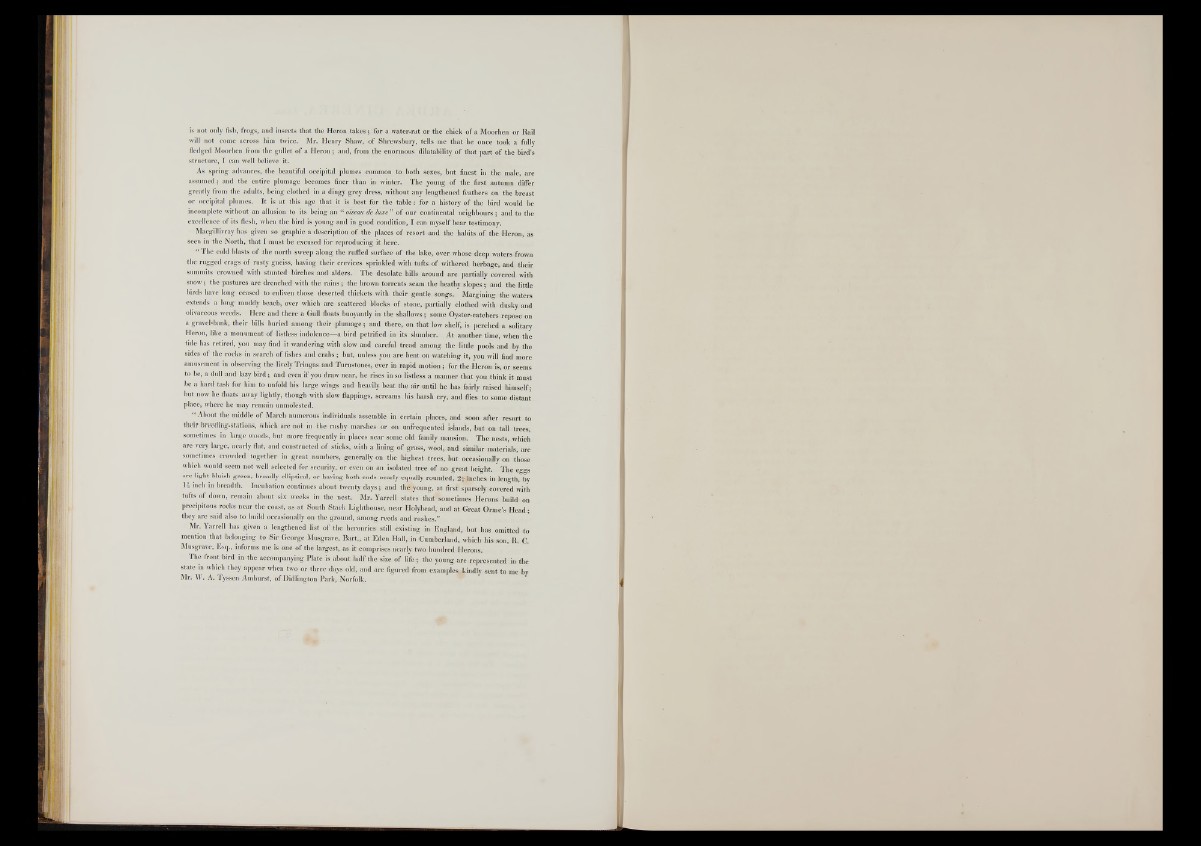
is not only fish, frogs, and insects that the Heron tak e s ; for a water-rat or the chick o f a Moorhen or Rail
will not come across him twice. Mr. Henry Shaw, of Shrewsbury, tells me that he once took a fully
fledged Moorhen from the gullet of a H e ro n ; and, from the enormous dilatability of that p art of the bird’s
structure, I can well believe it.
As spring advances, the beautiful occipital plumes common to both sexes, but finest in the male, are
assumed; and the entire plumage becomes finer than in winter. The young o f the first autumn differ
greatly from the adults, being clothed in a ding)' grey dress, without any lengthened feathers on the breast
or occipital plumes. It is a t this age that it is best for the tab le : for a history o f the bird would be
incomplete without an allusion to its being an “ oiseau de lu xe” o f our continental neighbours ; and to the
excellence of its flesh, when the bird is young and in good condition, I can myself bear testimony.
Macgillivray has given so graphic a description o f the places o f resort and the habits o f the Heron, as
seen in the North, that I must be excused for reproducing it here.
“ The cold blasts of the north sweep along the ruffled surface o f the lake, over whose deep waters frown
the rugged crags o f rusty gneiss, having their crevices sprinkled with tufts o f withered herbage, and their
summits crowned with stunted birches and alders. The desolate hills around are partially covered with
snow; the pastures are drenched with the rain s; the brown torrents seam the heathy slopes; and the little
birds have long ceased to enliven those deserted thickets with their gentle songs. Margining the waters
extends a long muddy beach, over which are scattered blocks o f stone, partially clothed with dusky and
olivaceous weeds. Here and there a Gull floats buoyantly in the shallows; some Oyster-catchers repose on
a gravel-bank, their bills buried among their plumage; and there, on that low shelf, is perched a solitary
Heron, like a monument of listless indolence—a bird petrified in its slumber. At another time, when the
tide has retired, you may find it wandering with slow and careful tread among the little pools and by the
sides o f the rocks in search of fishes aud c rab s; but, unless you are bent on watching it, you will find more
amusement in observing the lively Tringas and Turnstones, ever in rapid motion; for the H eron is, o r seems
to be, a dull and lazy b ird ; and even if you draw near, he rises in so listless a manner that you think it must
he a hard task for him to unfold his large wings and heavily beat the air until he has fairly raised himself ;
but now he floats away lightly, though with slow flappings, screams his harsh cry, and flies to some distant
place, where he may remain unmolested.
“ About the middle o f March numerous individuals assemble in certain places, and soon after resort to
their breeding-stations, which are not in the rushy marshes or on unfrequented islands, but on tall trees,
sometimes in large woods, but more frequently in places near some old family mansion. The nests, which
are very large, nearly flat, and constructed of sticks, with a lining o f grass, wool, and similar materials, are
sometimes crowded together in great numbers, generally on the highest trees, but occasionally on those
which would seem not well selected for security, or even on an isolated tree of no great height. The eggs
are light bluish green, broadly elliptical, o r having both ends nearly equally rounded, 2ianches in length, by
In inch in breadth. Incubation continues about twenty days; and the-young, a t first sparsely covered with
tufts of down, remain about six weeks in the nest. Mr. Yarrell states th a t;sometimes Herons build on
precipitous rocks near the coast, as at South Stack Lighthouse, near Holyhead, and at Great Orme’s Head •
they are said also to build occasionally on the ground, among reeds and rushes.”
Mr. Yarrell has given a lengthened list of the heronries still existing in England, but has omitted to
mention that belonging to Sir George Musgrave, Bart., at Eden Hall, in Cumberland, which his son, R. C.
Musgrave, Esq., informs me is one o f the largest, as it comprises nearly two hundred Herons.
The front bird in the accompanying Plate is about half the size o f life; the young are represented in the
state in which they appear when two or three days old, and are figured from examples^kindly sent to me by
Mr. W. A. Tyssen Amhurst, o f Didlington Park, Norfolk.